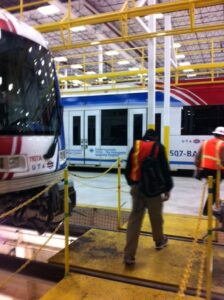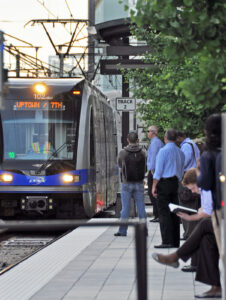Nov. 10, 2014 – Railroads have used RFID to track cars and equipment for decades. Now rail operators, from Class 1 to regional light rail, can use advanced RFID solutions to track equipment usage and condition for predictive maintenance by automating information capture related to critical components.
The Swiftsure Group, a systems integrator specializing in RFID-based resource management, has found that this predictive approach improves service reliability by avoiding unscheduled stoppages and delays from equipment malfunctions and breakdowns.

Light rail gets on board with RFID for predictive maintenance
“It’s crucial for transportation companies to maintain efficient operations and maximize uptime,” said Swiftsure’s Bruno Riegl. “Protecting revenue streams by preventing service interruption is of paramount importance to commuter and light rail passenger service operators.”
Successful preventative maintenance requires diligent planning and implementation procedures. Historically, it has been achieved through scheduling regular equipment inspections and maintaining surplus spares and replacement parts – practices that can be expensive in terms of labor and idle capital. Inspecting equipment on a fixed schedule also doesn’t address how frequently equipment is used and whether it is subjected to accelerated depreciation or wear and tear.
Getting up to speed with RFID
Though using RFID-based automatic equipment identification (AEI) has become standard practice, RFID is generally underutilized by railcar operators in the broader management of resources, spare parts and ancillary equipment.
Automating the identification of equipment that is due for service or replacement, coupled with event management and notification software, can improve operational reliability while reducing labor costs associated with employees having to manually locate and identify equipment within service yards. At the same time, integrated equipment identification and notification solutions enable rail operators to carry fewer spares and link parts reorder to anticipated equipment replacement and refurbishment cycles.

Predictive maintenance helps build ridership and revenues
For light rail and regional commuter train operators with relatively small fleets and compact service facilities, RFID is an affordable, efficiency-enhancing technology that yields a quick ROI with relatively easy implementation.
RFID identification equipment can be placed at choke points such as service yard entrances, where RFID tagged railcars and attached equipment can be automatically identified as they pass RFID readers. The information is then sent either wirelessly or via Ethernet links to backend information management systems. Equipment usage can be tracked and associated with activities such as miles travelled and frequency of equipment in-service time. In response to this information, the railcar operator can establish service scheduling, parts replacement and refurbishment according to actual usage instead of to fixed time schedules that may not reflect actual equipment service needs.
Real-time resource management for rail
Building intelligent operations systems incorporating RFID therefore enhances rail operators’ performance by ensuring that equipment servicing is done only when necessary based on predictive needs, lowers labor costs by automating equipment location and improves operating efficiencies by lessening the chances of equipment failure during normal operations.
Conditions-based monitoring systems provide railcar operators with real-time intelligence and analysis of the health of their rolling stock, and can be extended to other operational functions such as optimizing the level of spare parts and consumable inventory by linking actual equipment usage to predictive replacement schedules based on analysis of real-time equipment usage cycles.
Railroads worldwide have been at the forefront in harnessing the potential of RFID for fleet management to track rail cars and motive power. In the US, the Burlington Northern conducted the first serious testing of RFID applications for railroads in 1986, which showed 99.99% accuracy of railcar tracking over an extended trial period. Subsequent testing by other railroads such as Union Pacific, CSX, Norfolk Southern and Canadian National led to the adoption of AEI standards by the American Association of Railroads in the early nineties.
